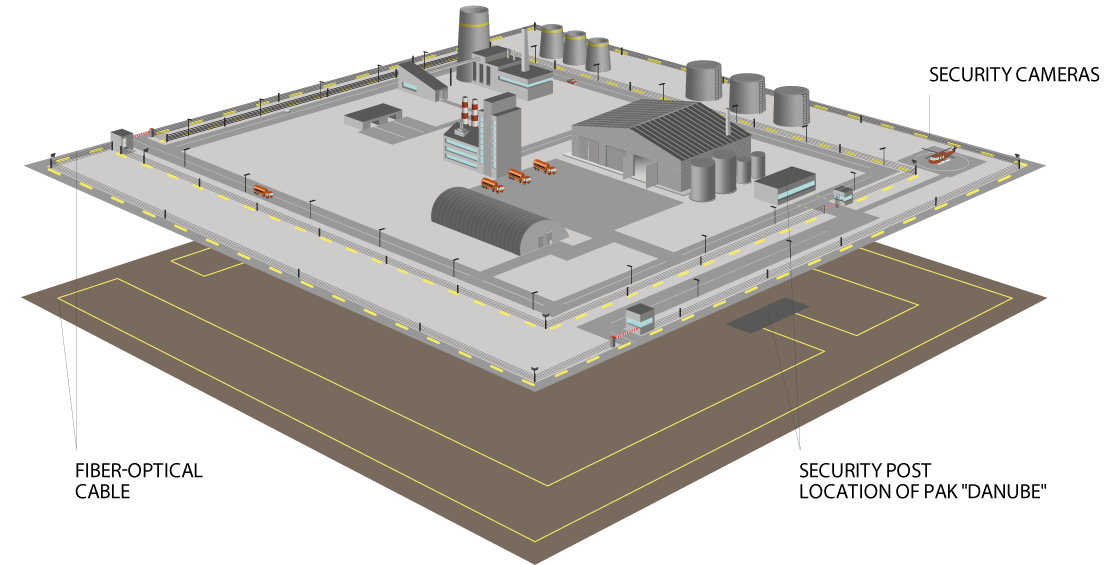PAK “Danube” successfully operates as part of the perimeter security complex of the Domodedovo International Airport (Moscow)
The equipment is installed and operated at the international airports of Omsk and Tyumen
The system was tested at the NIKIRET test site
Traditional means of perimeter security – cameras, unmanned aerial vehicles and security teams require continuous monitoring of the entire length of the border 24/7, so the main task of the security service is not the physical protection of the facility, but the timely detection of an intruder and the prevention of possible adverse events.
- – attempts to enter the territory of a protected facility
- – activity in the security zone near the perimeter
- – damage to the integrity of the perimeter fence

DAS technology is used to protect the perimeters of such objects as:
- – airports and seaports
- – large industrial and sensitive enterprises
- – specially protected cultural heritage zones
- – government agencies
- – pipelines and other extended objects
- – polygons for various purposes
A multifunctional system for technological monitoring and protection of critical facilities is used to solve the following tasks:
- – timely detection of the intruder
and informing the duty services about the fact of a violation (penetration of a protected facility) - – recording the time and place of violation (geographical coordinates and distance to pickets / control objects)
- – the ability to detect an intruder before crossing the line (recording attempts to climb over the fence, break it, or undermine it)
- – recognition of the type of intruder, in some cases – determination of the direction and speed of his movement, the location and nature of the impact on the perimeter fence
- – remote monitoring of the state of the boundaries of monitoring objects, the actions of violators and duty services
- – automatic documentation of detected events
Benefits and features
PAK “Danube” provides operators with extensive capabilities for detecting vibroacoustic events. When installing the system, T8 Sensor specialists carry out individual configuration of the system, taking into account the characteristics of each object.
There are a number of advantages that distinguish the Danube PAK from other systems:
 Range:
Range:
- – up to 100 km when laying the sensor cable underground
- – up to 50 km when laying a sensor cable
along the fence (grid fence made of welded wire with a rod diameter of 2-7 mm; volumetric and flat reinforced barbed tape/wire; chain-link mesh stretched over a metal frame).
To determine the direction and speed of movement of the intruder, it is recommended to organize several security lines.
 Ease of operation of the linear part:
Ease of operation of the linear part:
- – no need for power supply and equipment at the far end of the line (power supply is supplied at the location where the equipment is installed)
- – immunity to electromagnetic interference
- – insensitivity of the system to external interference – industrial interference, noise of air, railway and road transport, wind from trees and movement of small animals
 Linearity of system response:
Linearity of system response:
Stable signal shape for 1 km, 20 km, 50 km and more due to the use of a coherent phase-sensitive reflectometer; no fading zones.
 Using the hidden linear part:
Using the hidden linear part:
A passive sensor cable buried in the ground does not allow identifying a boundary either visually or by measuring fluctuations in the electromagnetic field, since the sensor cable is a passive element of the system that is not a source of electromagnetic radiation. The use of a hidden sensor cable makes it difficult for potential violators to conduct reconnaissance of the area, allows preserving the landscape appearance of the monitoring object and using the system in specially protected cultural heritage areas.
 Early event detection
Early event detection
Classification of the impact source before crossing the sensitive element and the security line:
- – human steps – 5-10 m from the cable
- – manual digging – 15-30 m from the cable
- – movement of a passenger car – 50-60 m from the cable
- – movement and digging of heavy equipment—50-300 m from the cable
 Integration via open interfaces (API)
Integration via open interfaces (API)
with other installed monitoring, activity control and video surveillance systems
 Can be deployed on existing fiber infrastructure
Can be deployed on existing fiber infrastructure
 Maintaining system functionality in the event of a sensor cable break with localization of the event location
Maintaining system functionality in the event of a sensor cable break with localization of the event location

Options for constructing monitoring boundaries

Linearity of system response over the entire length of the sensor cable
System functions
Visualization of recognized events:
During commissioning, T8 Sensor specialists “mutually link” the cable sensor and pipeline (monitoring object) to any publicly available mapping platform (Google Maps, Yandex.Maps), or to an individual map format used by the customer.
The company’s engineers customize the system interface to meet customer requirements. Information about detected events is displayed on the operator’s screen in graphical form (on a diagram map) and in text (tabular) form. The operator can filter aggregated events for each severity category (alarm).
Integration
The maximum efficiency of the monitoring system is achieved when it is used in conjunction with other sets of technical means:
- – life support
- – energy supply
- – ACS
- – emergency protection system
- – emergency/security warning system
T8 Sensor is working on the integration of the monitoring system and unmanned aerial vehicles (UAVs). API for integration is carried out via xml, json, modbus.
Scaling:
The developed system architecture allows you to automatically combine up to 20 devices into a single complex, which allows you to cover more than 1,500 km.
The number of connected devices is limited only by the computing power of dedicated aggregation servers, which allow operators to work with the system remotely.
Each device of the Danube PAK can act as a server for five other systems. In addition, the system allows you to divide any monitoring object into an arbitrary number of zones with various customizable monitoring parameters.



